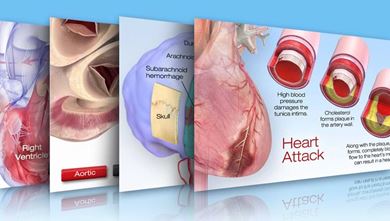Transesophageal Echocardiography (TEE)
What is transesophageal echocardiography?
Transesophageal echocardiography (TEE) is a test that produces pictures of your heart. TEE uses high-frequency sound waves (ultrasound) to make detailed pictures of your heart and the arteries that lead to and from it. Unlike a standard echocardiogram, the echo transducer that produces the sound waves for TEE is attached to a thin tube that passes through your mouth, down your throat and into your esophagus. Because the esophagus is so close to the upper chambers of the heart, very clear images of those heart structures and valves can be obtained.
Quick facts
- TEE is a test that uses sound waves to make pictures of your heart’s muscle and chambers, valves and outer lining (pericardium), as well as the blood vessels that connect to your heart.
- Doctors often use TEE when they need more detail than a standard echocardiogram can give them.
- The sound waves sent to your heart by the probe in your esophagus are translated into pictures on a video screen.
- After this test, you may have a mild sore throat for a day or two.
Why do people have TEE?
Doctors use TEE to find problems in your heart’s structure and function. TEE can give clearer pictures of the upper chambers of the heart, and the valves between the upper and lower chambers of the heart, than standard echocardiograms. Doctors may also use TEE if you have a thick chest wall, are obese, have bandages on your chest, or are using a ventilator to help you breathe.
The detailed pictures provided by TEE can help doctors see:
- The size of your heart and how thick its walls are.
- How well your heart is pumping.
- If there is abnormal tissue around your heart valves that could indicate bacterial, viral or fungal infections, or cancer.
- If blood is leaking backward through your heart valves (regurgitation) or if your valves are narrowed or blocked (stenosis).
- If blood clots are in the chambers of your heart, in particular the upper chamber, for example after a stroke.
TEE is often used to provide information during surgery to repair heart valves, a tear in the aorta or congenital heart lesions. It’s also used during surgical treatment for endocarditis, a bacterial infection of the inner lining of the heart and valves.
What are the risks of TEE?
The few risks of TEE involve passing the probe from your mouth down into your throat and esophagus. You will get medicines before the test to make you calm and to numb your throat. But you may feel like gagging. You may also have a sore throat for a day or two after the test. In very rare cases, TEE causes the esophagus to bleed.
How do I prepare for TEE?
Check with your doctor. He or she may ask you not to have alcoholic drinks for a few days before the test, and not to eat or drink anything for at least 4 to 6 hours before TEE. Because you receive a sedative to help you stay calm, someone should drive you home after the test.
What happens during TEE?
Specially trained doctors perform TEE. It’s usually done in a hospital or a clinic and lasts 30 to 60 minutes.
- A technician sprays your throat with a medicine to numb it and suppress the gag reflex. You’ll lie on a table.
- A nurse puts an IV (intravenous line) in your arm, and gives you a mild sedative (medicine) to help you stay calm.
- The technician then places small metal disks (electrodes) on your chest. He or she attaches the electrodes by wires to a machine that will record your electrocardiogram (ECG) to track your heartbeat.
- The doctor then gently guides a thin, flexible tube (probe) through your mouth and down your throat, and asks you to swallow as it goes down.
- A transducer on the end of the probe sends sound waves to your heart and collects the echoes that bounce back. These echoes become pictures that show up on a video screen. This part of the test takes 10 to 15 minutes.
- When the doctor is finished taking pictures, the probe, IV and electrodes are removed and nurses watch you until you are fully awake. Then you can usually get up, get dressed and leave the clinic or hospital.
"The doctor was talking to me about the tube going into my throat, and before I knew it, he told me the test was over.” Iris, age 68
What happens after TEE?
Your throat may be numb for a short time. Don’t eat or drink anything until the numb feeling goes away — you could choke.
- You may have a little trouble swallowing right after the test, but this will go away within a few hours.
- It’s common to have a sore throat for a day or two after the test.
- Because of the sedative you get during the procedure, don’t drink alcohol for a day or two.
"My voice was a little hoarse the day after my test, but my throat didn’t really hurt.” Martin, age 54
What should I watch for?
If your sore throat gets worse or doesn’t go away after a few days, call your doctor.
How can I learn more about TEE?
Talk with your doctor. Here are some good questions to ask:
- Why can’t you perform a regular echocardiogram to get pictures of my heart?
- What will you learn from this test?
- When will I know the results of the TEE?
- Can I go back to work on the day of the test?








